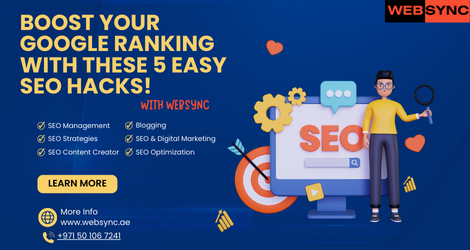How to Improve Your Website’s SEO in 5 Easy Steps
Improving your website’s SEO is essential for driving organic traffic and increasing visibility on search engines. If you’re just starting, you may wonder how to improve website SEO without feeling overwhelmed. However, with the right steps, you can easily enhance your website’s performance and ensure that search engines rank your site higher. Whether it’s by optimizing keywords or improving load speed, the process is simpler than you think. Here’s a beginner-friendly guide that will take you through five easy steps to improve your website’s SEO, making your site more accessible to potential customers.
1. Optimize Your Keywords
Keywords play a crucial role in SEO. They are the words or phrases people type into search engines when looking for information. Here’s how you can optimize your keywords effectively:
- Research the Right Keywords: Use tools like Google Keyword Planner or Ubersuggest to find relevant keywords. Look for terms that have a good search volume but low competition.
- Use Long-Tail Keywords: These are more specific keywords that may have lower search volume but are highly targeted. For example, instead of just using “digital marketing,” you could use “affordable digital marketing services in Dubai.”
- Place Keywords Naturally: Use keywords in your titles, headers, meta descriptions, and throughout your content. But avoid keyword stuffing. Make sure it sounds natural.
Key Tip: Start with two to three main keywords for each page and spread them evenly.
2. Improve Your Website’s Loading Speed
Website speed is crucial for both user experience and SEO. A slow-loading site will not only frustrate your visitors but also harm your SEO ranking. Google considers page speed when ranking sites.
Here’s how to improve it:
- Optimize Images: Large image files can slow down your site. Use compressed images that load faster without sacrificing quality. Tools like TinyPNG can help reduce image sizes.
- Use Browser Caching: Browser caching stores your website’s files on the visitor’s browser. This reduces loading time when they visit your site again. Enable caching to improve load speed.
- Minimize HTTP Requests: Each element on your webpage (images, scripts, stylesheets) requires an HTTP request. The fewer requests, the faster the page loads. Combine files where possible.
Key Tip: Use Google PageSpeed Insights to analyze your site’s speed and get specific recommendations for improvement.
3. Create High-Quality Content
Content is king when it comes to SEO. Search engines prioritize websites that offer useful, engaging, and high-quality content.
Here’s what you need to focus on:
- Provide Value: Your content should provide answers to your audience’s questions. Write blog posts, guides, and articles that address common concerns or interests.
- Use Headings and Subheadings: Properly structured content is easier to read and scan. Use headers (H1, H2, H3) to organize your text. This also helps search engines understand your content.
- Incorporate Visuals: Add images, videos, and infographics to make your content more engaging. Ensure you include alt text for images, as this helps search engines index them.
Key Tip: Write for your audience, not for search engines. While keywords are important, user engagement is crucial.
4. Ensure Mobile-Friendliness
With more than half of internet users browsing on mobile devices, having a mobile-friendly website is essential for SEO. Google uses mobile-first indexing, meaning it ranks websites based on how well they perform on mobile devices.
Here’s how to make your website mobile-friendly:
- Responsive Design: Ensure your website adjusts to different screen sizes, whether on desktops, tablets, or mobile phones. Use a responsive design that automatically scales to fit the screen.
- Optimize for Touchscreens: Make sure buttons and links are easy to tap on a mobile device. If users have to zoom in or struggle to click on elements, your site may suffer.
- Reduce Pop-Ups: Pop-ups on mobile devices can be intrusive and frustrating. If you use pop-ups, ensure they are small and easy to close.
Key Tip: Test your site on various devices to ensure it looks good and works properly everywhere.
5. Build Backlinks
Backlinks are links from other websites that point to your site. Search engines see backlinks as a vote of confidence, which can boost your SEO ranking. The more high-quality backlinks you have, the more trustworthy your site appears.
Here’s how to build backlinks:
- Guest Blogging: Write valuable content for other websites in your industry. In exchange, you can include a link back to your website in the author bio or within the content.
- Create Shareable Content: If your content is informative and engaging, other sites may link to it. Focus on creating guides, infographics, and original research that people want to share.
- Reach Out to Influencers: Collaborate with influencers or industry leaders to share your content on their platforms. This can drive traffic and help you gain valuable backlinks.
Key Tip: Avoid buying backlinks or using low-quality link-building schemes. Focus on organic and natural backlinks from reputable sites.
Bonus Tips for SEO Success:
- Use Internal Linking: Link to other relevant pages on your website to help search engines understand the structure of your site.
- Update Old Content: Regularly refresh old blog posts and articles with new information to keep them relevant.
- Use Clean URLs: Ensure your URLs are easy to read and include keywords relevant to the page’s content.
- Monitor Your Analytics: Use tools like Google Analytics to track your site’s performance. This can help you understand what’s working and what needs improvement.
Conclusion
Improving your website’s SEO doesn’t have to be complicated. By following these five easy steps—optimizing keywords, improving load speed, creating high-quality content, ensuring mobile-friendliness, and building backlinks—you can significantly boost your site’s search engine ranking.
Remember, SEO is a long-term strategy. It requires consistent effort and regular updates, but the results are worth it. A well-optimized website will bring more organic traffic, better engagement, and higher conversions. Contact us at Websync if you need help with improving your website’s SEO or want to explore digital marketing solutions that fit your business needs.


